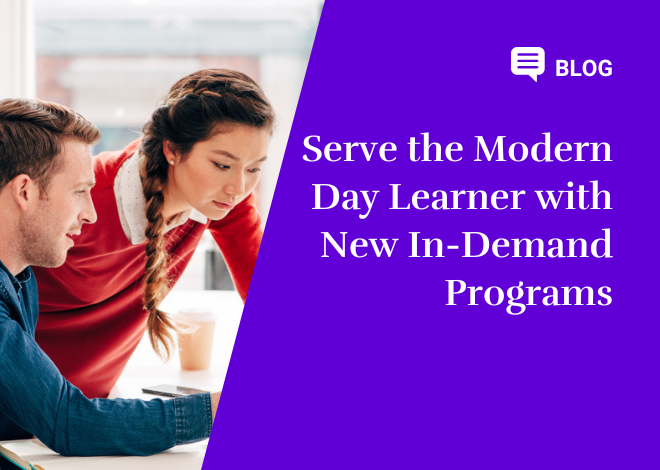Published by Acadeum
For years, higher education has heard about the enrollment cliff, and unfortunately, the issue is only getting closer and more pressing.Regional bachelor’s institutions are expected to lose more than 11 percent of their students by 2029.While this percentage varies by region, the Northeastern states are predicted to be hardest hit. There are other forces at play as well, including changing demands in the labor force, the rise of low-cost, short-term alternative credentials, and changes in funding and financial aid.
Institutions need to prepare for shifts in demographics, enrollment, learner expectations, and workforce demand. This is certainly no easy feat. In an effort to address these pressures, I have connected with industry colleagues to capture perspectives on how institutions can be reimagining the ways to serve the modern-day learner.
Introducing the Modern-Day Learner
Over the last five years, higher education has started to think differently about what we have called the traditional undergraduate student, and this thinking will only continue to evolve over the next 10 years. For example, many of today’s students are first-generation college students and are caring for dependents in their own families. I recently spoke with Eugene So, managing director of Lifelong Learning at Jobs for the Future, who said, “Seventy-five percent of students exhibit certain characteristics that we didn’t see in the past. A large percentage of them are working part-time or full-time. How we think about the value for students in higher education is understanding that meeting the needs of immediate utilization of learning and moving towards a portfolio of lifetime value is a way that we can shift how we deliver education to students to encourage lifelong learning.”
Institutions must respond to the evolving definition of the modern-day learner and consider how they can support them. Traditionally, LaGrange College has served as an undergraduate institution. I recently spoke with Jon Ernstberger, associate vice president of Academic Affairs at LaGrange College, about how he’s seen the undergraduate student change into the modern-day learner. Ernstberger noted that student responsibility has shifted, and said, “So many of my students are taking care of loved ones who are elderly or have some kind of a disability. And all of my students are working. This is their new reality.”
These responsibilities signal a change in traditional undergraduate populations, among so many other aspects. As a result, institutions must shift the way they deliver learning experiences, and the type of support they offer these students, too. As a result, many institutions are looking for ways to add additional academic pathways, and finding ways to be more nimble and responsive in helping them succeed to graduation, with an increased focus on employability.
How Acadeum Helps Institutions to Support the Modern-Day Learner
In preparing learners for an ever-changing workforce, Acadeum is a strategic partner for institutions looking for sustainable and relevant solutions to deliver courses, certificates, and programs by working in collaboration across the Acadeum network of accredited institutions and workforce-aligned partners.
Acadeum helps institutions quickly and affordably make adjustments to catalog offerings, modalities, and resource allocation, all of which allow them to be nimble and responsive in these changing times. By expanding academic capacity with a variety of strategic curricular options, institutions can better respond to and support the modern-day learner.
Course Sharing
Acadeum has supported course sharing from the beginning. With over 475 institutions, Acadeum represents the largest network in the industry. Studies show that students who encounter scheduling barriers have a 42 percent chance of stopping out. Our partners access an inventory of thousands of courses delivered by hundreds of fellow accredited institutions to provide a course requirement that may not be available at a student’s own institution precisely when they need it.
Program Sharing
We’re increasingly working with institutions to think more intentionally about planfully using consortial course sharing to efficiently and effectively support their academic portfolio. This is a collaboration between institutions in the Acadeum network to help bolster, sustain, or launch new in-demand offerings quickly and affordably. Program collaboration enables colleges and universities to access or share high-quality courses across in-demand programs.
It also offers institutions a low-risk way to enrich educational experiences on campus by integrating courses from regionally accredited partner institutions and vetted in-demand workforce certification partners to launch or enhance undergraduate and graduate programs, concentrations, or minors while maintaining institutional mission and values.
Skills Marketplace
For institutions serving the modern-day learner, speed to market matters. The ability to find specialized faculty and content and integrate short-term or long-term stackable credentials within a pathway that leads to different milestones within degrees is also crucial. There are already over 380 in-demand offerings available in the Acadeum Skills Marketplace, and institutions can also market their own offerings. The Acadeum Skills Marketplace bridges education and career pathways as institutions access industry credentials and professional certifications, so that learners can acquire workforce skills on their education-career continuum.
A Roadmap for the Future
Collaborating through the network helps institutions lower risk and manage challenges in offering relevant learning opportunities amidst changing skill requirements. Collaboration encourages innovation while minimizing investments to ensure sustainability and affordability.
This collaborative approach is crucial to Acadeum’s mission. Considering the importance of portfolios in managing academic operations, collaboration becomes essential, especially with increasing operational costs. The marketplace offers institutions new opportunities to attract and retain learners, with the potential to convert them into degree offerings over time.
Assessing academic portfolios against market demand is essential to strategically prepare for enrollment shifts and challenges, and to cater to the needs of modern-day learners. We encourage institutions to engage with our team of experts to develop a customized plan based on the strategic goals of your institution.



